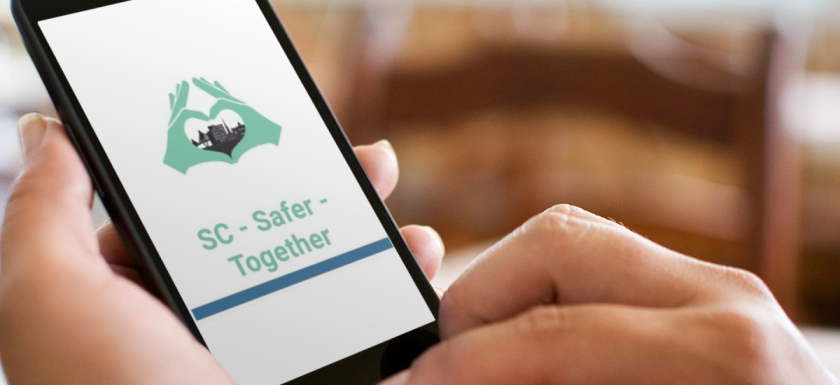
JMIR Publications recently published “Dissemination and Implementation of a Google Apple Exposure Notification System for COVID-19 Risk Mitigation at a National Public University: Protocol for a Pilot Evaluation Study in a Real-World Setting“ in JMIR Research Protocols which reported that this paper describes the protocol for South Carolina Safer Together, developed by Clemson University to design, deploy, and evaluate multilevel communication and dissemination and implementation (D&I) strategies in line with recommendations from governmental and educational agencies to mitigate the risk of exposure to COVID-19.
Safer Together was enhanced by the addition of the Google/Apple Exposure Notification app, an alternative strategy to support a recommendation of COVID-19 testing outcomes:
- Contact tracing
- Isolation, and
- Quarantine.
This study aimed to describe the content and intended audiences of D&I strategies used to deploy recommended COVID-19 mitigation strategies on a major college campus; determine the reach, acceptability, adoption, and use of D&I strategies among the target audiences (university students, faculty, and staff); and characterize barriers and facilitators to the implementation and use of recommended mitigation strategies.
The study team incorporated elements of the Health Belief Model, the Technology Acceptance Model, communication and social marketing models, and the Reach, Effectiveness, Adoption, Implementation, and Maintenance framework to identify and develop appropriate constructs and specific outcomes for inclusion in our approach to evaluate the communication, dissemination, and implementation processes related to the deployment of Safer Together at Clemson.
Researchers offer roadmap for rolling out COVID-19 risk mitigation initiatives at educational institutions @MUSCHealth https://t.co/sPLpQ8o2Nx
— Medical Xpress (@physorg_health) February 1, 2022
On a local level, the broad adoption and use of Safer Together may help reduce COVID-19 transmission and keep the university “open.” On a larger scale, lessons learned on how to influence student and employee behavior with respect to the use of a public health outbreak prevention tool including Safer Together may be applicable in future pandemic and outbreak situations.
This study proposes a structured theory-driven approach to evaluate dissemination and implementation strategies associated with the deployment of Safer Together in a university setting from the viewpoint of students, employees, and university leadership.
Dr. Kathleen B Cartmell from Clemson University said, “As SARS-CoV-2, the virus that causes COVID-19, spread rapidly across the United States in the spring of 2020, institutions of higher education (IHEs) faced numerous challenges associated with minimizing the risk of exposure to COVID-19 among their students, faculty, staff, and surrounding communities.”
To address the recommended strategy of implementing actions to support testing outcomes such as contact tracing, isolation, and quarantine, Clemson also took advantage of a novel partnership among the state public health authority for South Carolina, the SC Department of Health and Environmental Control, Google, and Apple.
Compared to conventional contact tracing based on “case” recollection, cellphone-based exposure notifications have the potential to inform individuals of exposures more quickly, to identify a more complete set of true contacts, and to better assess extent of exposure.
The first round of student messaging regarding recommended strategies and the use of Safer Together was initiated through Clemson Student Housing on October 28, 2020, to students in the two dormitories.
Messaging for students was sent via email to explain Safer Together and its capacity to let students know if they had been exposed to someone with confirmed COVID-19, encourage them to download the app, link the app to the Healthy Clemson United as Tigers app, and understand what to do should they be notified of potential exposure.
Given the small size of this pilot with students in only 2 dormitories and that on-campus isolation was not a burden to the university employees, Clemson’s administration disseminated messaging about Safer Together to all Clemson employees on November 20, 2020, via an email asking them to download and activate Safer Together and advising them of the effort to evaluate Safer Together deployment strategies.
Dr. Cartmell and the research team concluded in their JMIR Publications Research Output, “This study proposes a structured approach based on the RE-AIM framework, to evaluate dissemination and implementation strategies associated with deployment of the Safer Together in a university setting from the viewpoint of students, employees and university leadership. The results of this study will inform future implementation of apps such as Safer Together at major state universities.”
###
DOI – https://doi.org/10.2196/32567
Full-text – https://www.researchprotocols.org/2022/1/e32567/
Free Altmetric Report – https://researchprotocols.altmetric.com/details/120186184
Keywords – COVID-19, risk, mitigation, mobile phone technology, exposure notification system, university setting, implementation science, implementation, dissemination, notification, university, exposure, transmission, communication, strategy, outcome, acceptability, adoption, usage
JMIR Publications is a leading, born-digital, open access publisher of 30+ academic journals and other innovative scientific communication products that focus on the intersection of health and technology. Its flagship journal, the Journal of Medical Internet Research, is the leading digital health journal globally in content breadth and visibility, and it is the largest journal in the medical informatics field.
To learn more about JMIR Publications, please visit https://www.JMIRPublications.com or connect with us via:
YouTube – https://www.youtube.com/c/JMIRPublications
Facebook – https://www.facebook.com/JMedInternetRes
Twitter – https://twitter.com/jmirpub
LinkedIn – https://www.linkedin.com/company/jmir-publications
Instagram – https://www.instagram.com/jmirpub/
Head Office – 130 Queens Quay East, Unit 1100 Toronto, ON, M5A 0P6 Canada
Media Contact – Communications@JMIR.org
The content of this communication is licensed under the terms of the Creative Commons Attribution License (https://creativecommons.org/licenses/by/4.0/), which permits unrestricted use, distribution, and reproduction in any medium, provided the original work, published by JMIR Publications, is properly cited.
JMIR Publications is a registered trademark of JMIR Publications.
